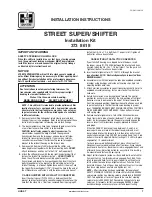
WARNING
■
The tyre inflation hose and air compressor may get hot as the tyre is being
inflated – there is a risk of injury.
■
Do not place the hot tyre inflation hose or hot air compressor on flammable
materials – there is a risk of fire.
■
If you cannot inflate the tyre to at least 2.0 bar, this means the damage sus-
tained was too serious. The sealing agent cannot be used to seal the tyre.
Do not drive the vehicle. Seek help from a specialist garage.
CAUTION
Switch off the air compressor after running 8 minutes at the latest – there is a
risk of overheating. Allow the air compressor to cool a few minutes before switch-
ing it on again.
Check after 10 minutes' driving
First read and observe the introductory information and safety warn-
ings on page 181.
Check the tyre inflation pressure after driving for 10 minutes!
If the tyre pressure is 1.3 bar or less
›
Do not drive the vehicle!
You cannot properly seal with tyre with the break-
down kit.
›
Seek help from a specialist garage.
If the tyre pressure is 1.3 bar or more
›
Adjust the tyre inflation pressure to the correct value (see inside of fuel filler
cap).
›
Continue driving carefully to the nearest specialist garage at a maximum speed
of 80 km/h.
Jump-starting
Introduction
This chapter contains information on the following subjects:
Jump-starting using the battery from another vehicle
184
Jump-starting in vehicles with the START-STOP system
184
WARNING
■
A discharged vehicle battery may already freeze at temperatures just below
0 °C. If the battery is frozen, do not jump start with the battery of another ve-
hicle – there is a risk of explosion.
■
Pay attention to the warning instructions relating to working in the engine
compartment
» page 156
,
Engine compartment
.
■
The non-insulated parts of the terminal clamps must never touch each other
– there is a risk of short circuit.
■
The jump-start cable connected to the positive terminal of the battery must
not come into contact with electrically conducting parts of the vehicle – there
is a risk of short circuit.
■
Do not clamp the jump-start cable to the negative terminal of the dis-
charged battery. There is the risk of detonating gas seeping out the battery
being ignited by the strong spark which results from the engine being started.
■
Route the jump-start cables so that they cannot be caught by any rotating
parts in the engine compartment.
■
Do not bend over the battery – there is a risk of caustic burns.
■
The vent screws of the battery cells must be tightened firmly.
■
Keep any sources of ignition (naked flame, lit cigarettes, etc.) away from the
battery – there is a risk of explosion.
■
Never jump-start vehicle batteries with insufficient acid levels – risk of ex-
plosion and chemical burns.
CAUTION
■
There must not be any contact between the two vehicles otherwise current
may flow as soon as the negative terminals are connected.
■
The discharged battery must be properly connected to the system of the vehi-
cle.
■
We recommend you buy jump-start cables from a car battery specialist.
183
Emergency equipment and self-help
Summary of Contents for 2013 Roomster
Page 1: ...SIMPLY CLEVER ŠKODA Roomster Owner s Manual ...
Page 8: ...Fig 1 Cockpit 6 Using the system ...
Page 212: ......
Page 213: ......
















































